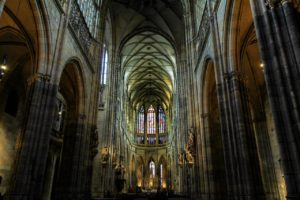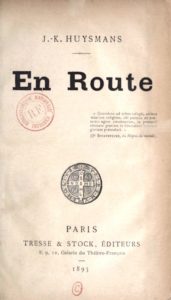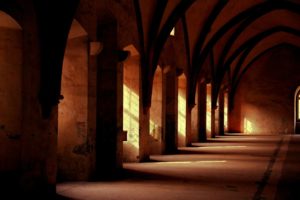 The late-nineteenth-century conversion story, En Route, by J. K. Huysmans is a book that penetrates deeply into the mind of the reader. It is an autobiographical yet fictional account of the return journey to the Church of a famous French art critic and novelist in decadent Paris.
The late-nineteenth-century conversion story, En Route, by J. K. Huysmans is a book that penetrates deeply into the mind of the reader. It is an autobiographical yet fictional account of the return journey to the Church of a famous French art critic and novelist in decadent Paris.
The book has weathered well the ravages of time since such conversion classics never lose their appeal. However, it is particularly suited to attract those who are route-less and rootless in this postmodern world. Life in Huysmans’ dissolute Paris had something of the search for meaning that haunts wandering souls today. Readers can easily insert themselves into the narrative and find their own searches represented.
The Story of a Great Sinner
Huysmans’ fictional character, Durtal, is a great sinner who has taken his vices to extraordinary depths, even to the point of exploring the dark abysses of Satanism. After a licentious life, he finds himself alone, disgusted and confused. There are no spiritual fireworks that illuminate him to his return to the Faith, it just happens. How he became a Catholic, he declares: “I cannot tell, all that I know is that, having been an unbeliever, I suddenly believed.”
His route back home is unique and twisted. Huysmans’ Durtal engages in a constant internal dialogue with himself as he struggles with the grand drama of his return home to the Church. It was no common journey for Durtal nor is it for readers.
 An Irresistible Magnet
An Irresistible Magnet
Indeed, Durtal was coaxed, lured and enticed into the Church by an “irresistible magnet that drew him to God,” by which “his soul had been shaken to its depths.” What moved him was the grand beauty of the Church—her architecture, art, and liturgy. The book is one magnificent canvas upon which the author takes flight, painting incredible descriptions, full of nuance and detail. Huysmans coaxes and entices readers to share in his own attraction and be moved in their “depths” by the brilliance of his vision.
The narrative is blessed with a great richness of thought that both overwhelms and subdues the postmodern mind little used to concentration. The reader struggles with long descriptions that at once cause impatience and wonder. His prose is a mixture of earthly observations and soaring heavenly considerations. The conflicts of postmodern and ancient, shallow and profound cause a nervous anxiety that finally invites one to a calm resignation to follow his spiritual odyssey wherever it might lead. If accepted, the reader is left spellbound to absorb the scenes and characters that appear.
Retreat in a Trappist Monastery
The route leads to Durtal’s weeklong retreat in the Trappist monastery of Notre Dame de l’Atre to complete the process of his conversion. In the solitude of the cloister, his soul is exposed to a more austere and terrible beauty, that shakes his soul yet deeper.
What Does Saint Thomas Say About Immigration?
Huysmans presents a violent clash with modernity made ever more spectacular with time. If people of his day found it hard to grasp the attractions of the monastic life, how much more the present noisy generations are confounded by its silent austerity. Today’s superficial souls cannot understand the meaning of the total isolation, long vigils and severe fasts assumed by the monks. Such practices are foreign to a world marked by lavishness and unbridled consumption. Their monastic embrace of suffering and discipline cannot help but shock delicate postmodern sensibilities.
Above all, people do not want to understand the gravity of sin and the role of the monks “who turn aside the wrath of heaven, and establish a solidarity in the good which is a counter-weight against the forces of evil.” Hence, modernity has always hated monks since they stand as a living reproach to the world’s excesses.
 A Marvelous Joy Radiating From the Cloister
A Marvelous Joy Radiating From the Cloister
This clash produces a shock but also an alluring attraction. In the midst of their suffering, Huysmans describes the supreme joy that radiates from the cloister. Readers of all times are drawn by a mysterious beauty, so ancient and so new, and then prompted to exclaim with Saint Augustine: Too late have I loved Thee!
What does Saint Thomas Aquinas say about Marriage?
The splendor of the divine worship and the action of grace disarms all objections.
Thus, Huysmans’ description of the Marian hymn, Salve Regina, leaves one rapt in wonder. He writes of unaccompanied “voices indifferent to themselves and blending in one only, masculine and deep, it rose with quiet boldness, sprang up with irresistible flight towards Our Lady, then made, as it were, a return upon itself, and its confidence was lessened, it advanced more trembling, but so different, so humble, that it felt itself forgiven, and dared then in passionate appeal to demand the undeserved pleasures of heaven.”
Contrary to Sentimental Piety
However, this is not a romantic spiritual journey that distorts reality. Durtal’s odyssey contrasts the reality of a great sinner in all his repugnance and the mercy of God in His unfathomable mercy and Providence. He presents his own miseries and trials without trying to excuse himself. He does not sugarcoat the mediocrity and wickedness of the times.
Huysmans minces no words in criticizing his epoch. His Durtal does not describe a golden age of Church art and music. As an art critic, he violently excoriates the bad music and architecture of decadent Paris. He deplores the sentimental piety of those who fail to see the Church’s sublime beauty and symbolism. One can only imagine what words of scorn he would have upon contemplating modern monstrosities!
[like url=https://www.facebook.com/ReturnToOrder.org]
Likewise, Durtal’s spiritual retreat at the Trappist monastery is not only a chronicle of special graces and consolations but a cascade of temptations, scruples and trials that are part of this vale of tears.
In these times of great trials for the Church, it does good to souls to contemplate the sublime beauty of the Church in all its splendor and hierarchy. Gazing upon Her beauty, it serves to solidify the certainty that the Catholic Church is one, holy, catholic and apostolic. Reading En Route is like making a spiritual retreat that helps one find the route back home. It also suggests that America’s solution lies in a Prodigal Son’s return like that of Huysmans.
As seen on The Imaginative Conservative.


